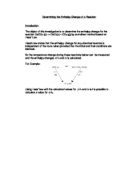Reaction 1- ∆H1
CACO3(s) + 2HCl (aq) CaCl2 (aq) + CO2 (g) + H2O (l)
I will use this formula to work out the number of moles of carbon carbonate CaCO3 used which is -: number of moles (n) =mass (m)/Molar mass (M)
Therefore: no. of moles= 2.47g/40.1+ 12.0 + (16x3) = 2.47/100.1 = 0.024mols of CaCO3.
I will now work out the enthalpy change using the formula: E= m x c x ∆T
Where m= mass of surroundings that experience the temperature
C= specific heat capacity and the ∆T= is the maximum temperature change (final temperature- initial temperature)
E=?
m= 50g
c= 4.2 Jg-1k-1
∆T= (25-24.50c) = 0.50c
E= m x c x ∆T
Therefore: 50g x 4.2 Jg-1k-1 x 0.50c
E= 105J
This means that 0.02 mols of CaCO3 reacted with 105J. I need to work out how much energy 1 mole of CaCO3 is. I will do the following:
0.02mols: 105J
I will divide both sides by 0.02mols
0.02/0.02: 105/0.02
1mol: 5,250.0J
I will convert the answer into KJ by dividing the answer by 1000
So: 5,250.0/1000 = 5.25 kJmol-1
∆H1 = - 5.25 kJmol-1
The reaction is exothermic because there is a negative sign is in front of the value indicating that heat is given out and it is therefore an exothermic reaction.
Reaction 2 ∆H2
CaO(s) + 2HCl (aq) CaCl2 (aq) + H2O (l)
I will find the number of moles of CaO using equation n=m/M
So: number of moles = 1.59g /Ca: 40.1+ 16= 56.1= 0.028 mols
E=?
m= 50g
c= 4.2 Jg-1k-1
∆T= (34.8-24.50c) = 10.30c
E= m x c x ∆T
Therefore: 50g x 4.2 Jg-1k-1 x 10.30c
E= 2,163.0J
This means that 0.028mols of CaO react to form 2.163.0J. I need to work out how much energy 1 mole of CaO is.
0.028mol: 2,163.0J
I will divide both sides by 0.028mols
1mol:77250.0
I will convert the answer into KJ by dividing the answer by 1000
So: 77250.0/1000 = 77.25kJmol-1
∆H2 = -77.25kJmol-1
Using Hess’s Law to find ∆H3
I need to work out the standard enthalpy change for the thermal decomposition of CaCO3 to CaO using Hess’s law.
Hess’s law states that the ‘total enthalpy change for a chemical reaction is independent of the route by which the reaction takes place , provided initial and final conditions are the same’ – quote from ‘Chemistry 1 ocr text book’.
∆H3
CaCO3(s) CaO (s) + CO2 (g) + 2HCl (aq)
∆H1
CaCl2 (aq) + CO2 (g) + H2O (l)
Route 1= Route 2
This means that ∆H3 = ∆H1 - ∆H2
I calculated the values for ∆H1 which is - 5.25 kJmol-1 and ∆H2 which is -77.25kJmol-1
Therefore: ∆H3 = - 5.25 kJmol-1 – ( -77.25kJmol-1)
= - 5.25 kJmol-1 + 77.25kJmol-1
∆H3 = + 72kJmol-1
This shows me my overall reaction was an endothermic reaction as the energy was gained by the system from the surroundings.
The actual value for the standard enthalpy value is 178. Since I know the actual answer I can now work out my percentage error. Using this formula:
Percentage error= 178 + 72kJmol-1 x 100 = 60% error
178
Evaluation






